Lime trial review Woady Yaloak
By Patrick Francis
The Woady Yaloak Catchment Group in western Victoria has completed a three year liming trial on grazing and cropping farms to help farmers make more informed decisions on lime applications. This article reviews the results from the pasture trial run on three farms.
The trial was established to investigate two aspects involved in lime applications decisions:
- The yield response to using lower rates of lime. Rule of thumb amongst many contractors is to apply 2000kg per hectare.
- The yield response to lime on soils that are in the ‘grey’ area between a liming and non-liming response. That is soil pH (measured in calcium chloride pHCa) is close to 5 and exchangeable aluminium percentage is below 5.
Kurdeez fine lime (neutralising value (NV) 97%) was broadcast applied in April 2012. Traditional fertiliser was broadcast on the three pasture sites at the same time. Rates applied are shown in table 1.
Table 1: Rate of lime products and traditional fertiliser applied.

Each pasture site started with a different nutrient status in terms of available phosphorus (P), potassium (K) and Sulphur (S), table 2. The traditional fertiliser treatments were applied as shown in Table 1 to bring the plots up to recommended nutrient levels (see appendices 1 and 2). The plots pHca are below optimum, table 2, and might benefit from lime.
Table 2: Soil and pasture type and key fertility, pHca, and exchangeable aluminum percentage at the three pasture sites.

Lisa Miller, a Southern Farming Systems agronomist suggests that pHca equal to or above 5.4, table 3, is an optimum to allow surface applied lime to move down the soil profile ( see her lime application review article on this site). Each sites’ exchangeable aluminum percentage is low and would not be expected to inhibit growth even of pasture species like phalaris and lucerne which are sensitive to the element. Below 5% exchangeable aluminum is recommended for the most sensitive pasture species.
Table 3: Likely responses to lime application over a range of pH and exchangeable aluminum levels.
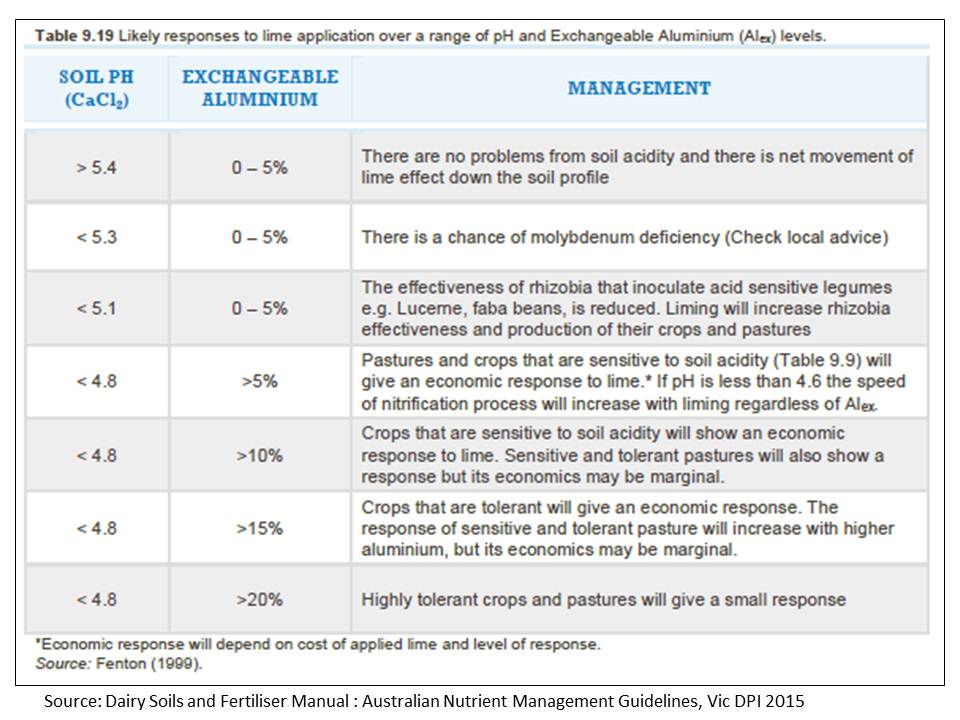
The results from the treatments have been combined to compare the difference in pasture dry matter production over the three years compared to the control which had no lime or fertiliser applied, figure 1.
Figure 1: Difference in pasture dry matter production from 2012 to 2014 compared to the control (nil treatment) at the three improved pasture sites.
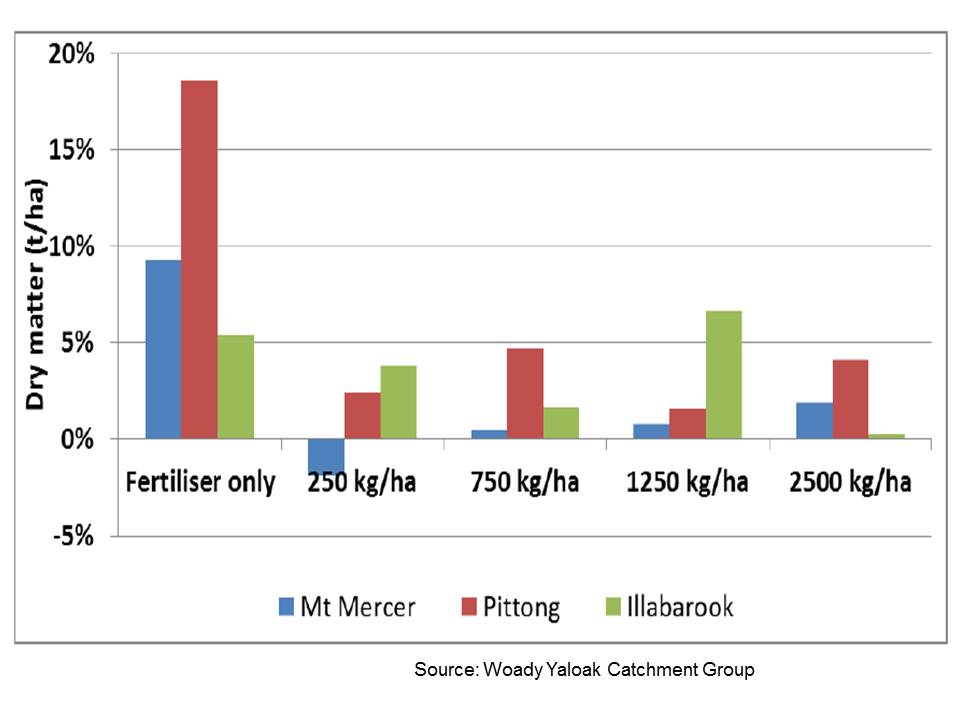
The most obvious message from figure 1 is that lime applications irrespective of rate across the sites had insignificant impact on pasture production. At two sites application of specific nutrients gave a significant increase in pasture production compared to the controls.
There are likely explanations for these results:
- At Pittong, soil was severely deficient in potassium. It received 100kg/ha/yr of sulphate of potash (41% K and 18% S) as well as lime which would have corrected the deficiency and subsequently pasture growth. With pHca of 5.2 and exchangeable aluminum at 0.6%, there is little reason to expect lime to have an effect at any rate.
- Mt Mercer was deficient in both K and P, optimum levels for clay loam pastures are considered to be 150 – 220 ppm Colwell K, and 14 – 20 ppm Olsen P. So the addition of 250kg/ha/yr super potash 2 & 1 (5.9% P and 16.7% K) would be expected to give a pasture growth response. The pHca of 4.8 could be expected as a level where a response to lime would become evident but that didn’t happen.
- The Illabrook site result is more puzzling because it had a very low Colwell K as well as a low pHca and was treated with 125 kg/ha/yr sulphate of potash (41% K and 18% S), but there was very little pasture response to K or lime.
The lime in this trial was applied in autumn 2012. Subsequent soil testing in November 2012 showed that the lime was acting moderately quickly to increase pHca depending on rate applied. Soil testing to depth also showed that the lime at 2500kg/ha was infiltrating the soil profile and increasing pHca to a depth of 40cm or more.
Lime impact on pasture composition
There is another aspect of using lime when pHca is less than 5, and that is on pasture composition. The trial report indicated that at the Pittong site sub clover production under lime was greater than the control plots. Such a result with sub clover and lime application is well known. An on-farm trial near Wagga Wagga NSW on very acid soil, pHca 4, with perennial and annual pastures dominated by sub clover (greater than 50% of the botanical composition), showed applying lime significantly increased sub clover growth and its percentage of the pasture composition (Reference: Long-term liming regime increases prime lamb production on acid soil, G Chen et al, University of Wollongong Research Online 2009).
The trial monitored lamb live weight gain per hectare and pasture carrying capacity over spring. It found that while lamb live weight gain per day was approximately the same on lime and un-limed plots, the limed plots carried approximately 26% more lambs per hectare which resulted in significantly higher lamb production per hectare.
In the trial increasing soil pH led to increased sub clover growth and less weed growth during spring. While such a result may look impressive, the impact of high sub clover pasture content (above 50%) on paddock ecosystem functions has not been considered. During summer and early autumn such a high percentage of sub clover usually means a high percentage of bare ground which has detrimental impacts on soil water holding capacity, nutrient runoff, soil erosion, and above and below ground biodiversity.
Take home message
The Woady Yaloak trial demonstrates that to accept rules of thumb about the impact on pasture production of any particular level of lime application or any additional nutrients is risky. Results from this trial and others generally show highly variable results when lime is applied at a range of rates. Keep in mind trials are usually designed around as few variables as possible in an attempt to generate a response to a treatment. In practice soils are highly complex physical, chemical and biological matrixes which are further complicated in farming by pasture species, methods of grazing management and variable climate. The most important indicator of pasture performance will be a measure which takes all these variables into account over time, while preserving each paddock’s ecosystem functions (water holding capacity, herbage cover, biodiversity above and below the surface and nutrient balance).
Decisions about soil inputs need to be made based principally on the trend in paddock carrying capacity and nutrient budgets which compare paddock nutrient inputs with paddock nutrient exports. It is also important to monitor the agricultural science based indicators for soil chemistry, physical structure and biological health. When these indicators demonstrate significant divergence from optimums it is wise to take corrective action before an impact on carrying capacity may become apparent. Remember the three biggest impacts on paddock carrying capacity are generally seasonal rainfall, pasture species present, and grazing management. Once the latter two are in place to the farmers’ satisfaction then desired production levels can be determined by fine tuning paddock soils for optimum nutrient and element levels, physical structure and biological health.
Find out more: Southern Farming Systems has the entire Woady Yaloak liming trial report, plus it own liming trial results on its web site: www.sfs.org.au and click on “research”.
Appendix 1: Soil test guidelines for Olsen P and Colwell P for pastures to achieve desired potential yields. Source: Dairy soils and fertiliser manual, Vic DPI 2015.
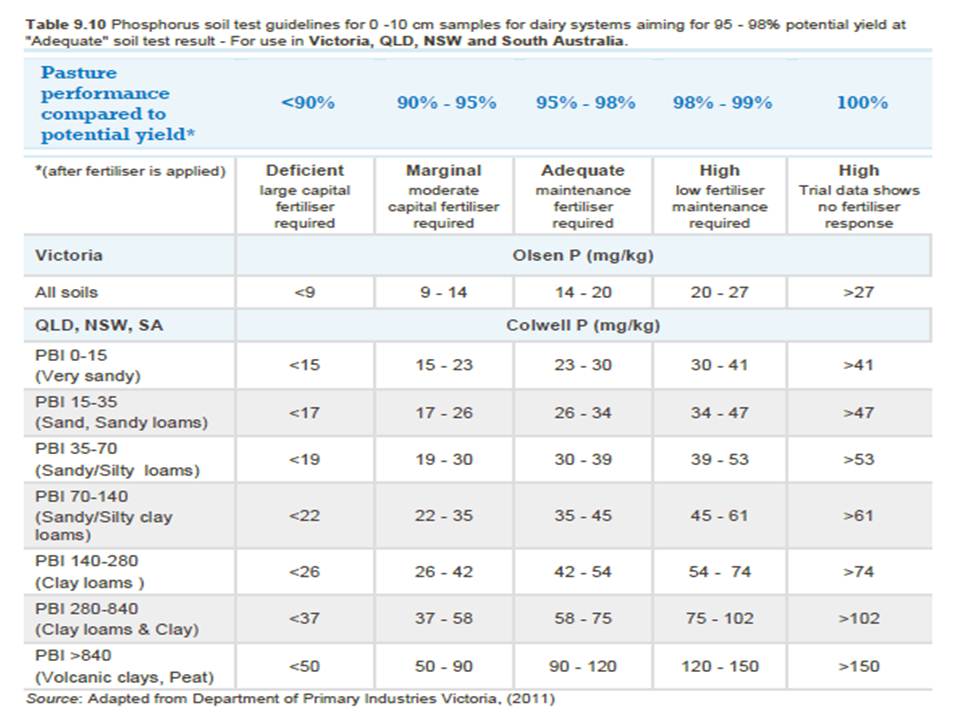
Appendix 2: Soil test guidelines for Colwell K. Source: Dairy soils and fertiliser manual, Vic DPI 2015.
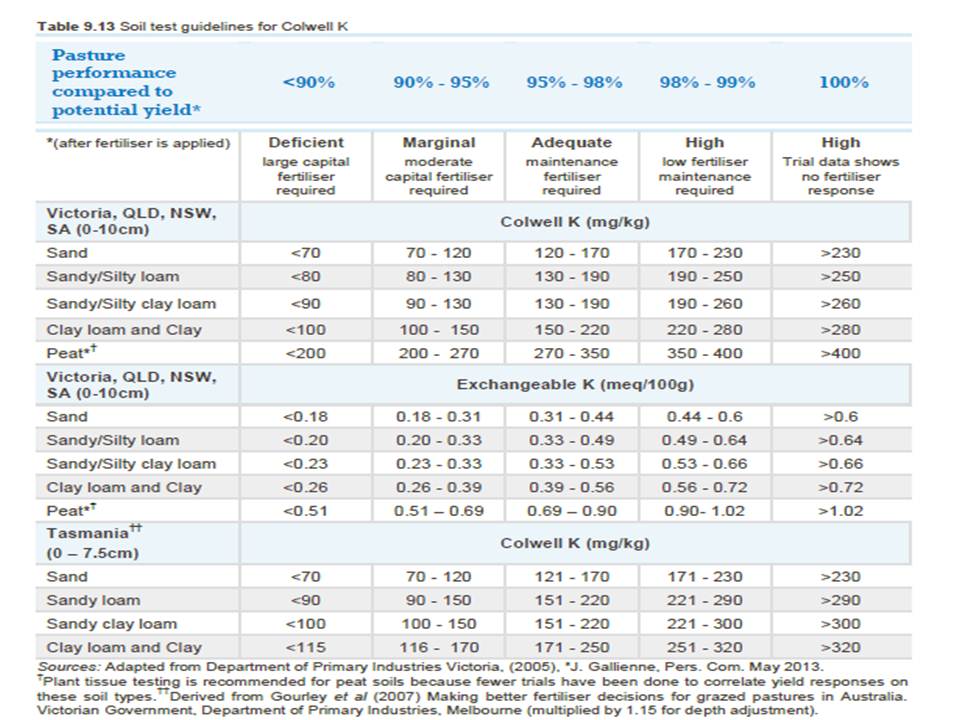

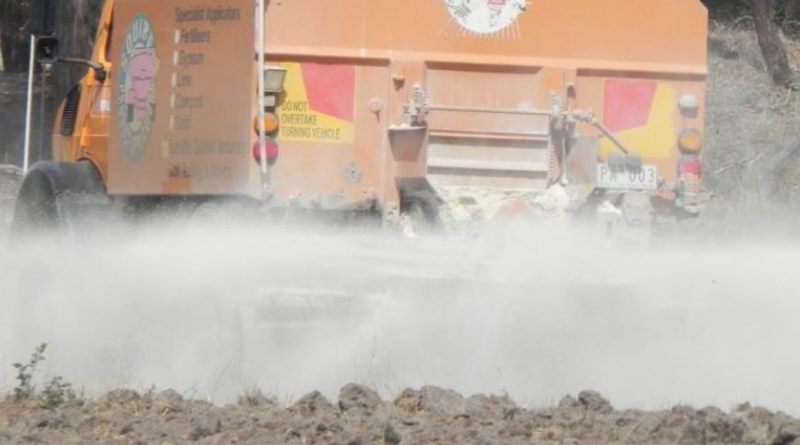
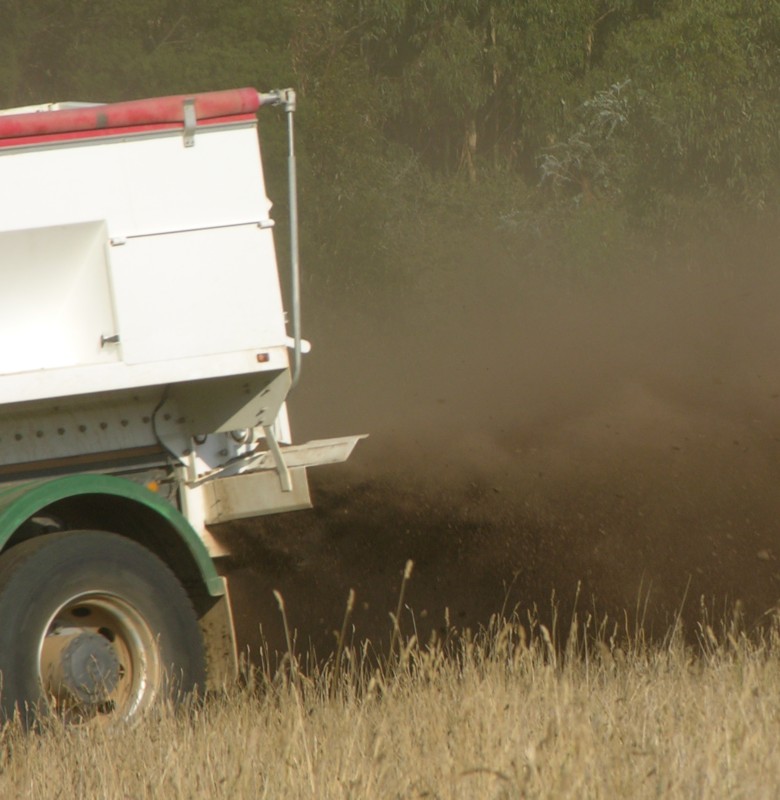
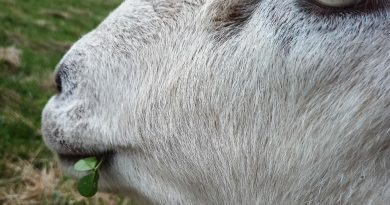
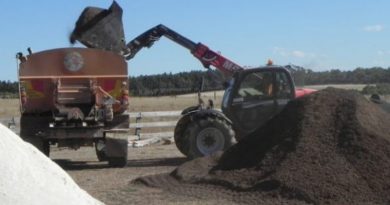
Could it be that results for lime application will always be inconsistent because:-
As a mature age student I returned to studies at Charles Sturt University. An obsevation was that lime experiments varied as to outcome and wondered if there was an identifiable reason. I remembered the self buffering grey cracking clay in the Wimmera region of Victoria (ancient sea bed).
This was after an agronomy prac for kelp based products (KBP) whereupon, I noted that field experiments varied as to outcome and a very likely reason after enquiry was that the processing temperature for KBP sometimes exceeded 80 degrees. (beneficial nitrogen fixing bacteria were being killed in the process). Useing a mix of the bacteria and sugar, I grew monstorous tomatoes in the back yard. A consequence was that soil pH dropped dramatically. The question was how to solve the problem?
I went on to discover that any lime has spores of crustaceous red algae (CRA) (even from the Nullabor and Margaret River) When activated and placed in an aqueous solution with sugar, they mine the calcium from limestone, crushed granite or egg shells. Applied to soil as an aqueos solution the (CRA) buffer the soil pH by feeding on soil carbon and or sucrose at the plant root with outstanding results. Small white granules just like those of the Wimmera soil are often visible.
My largest field trial has been an 18 hole golf course at Lindenow South Victoria where kikuyu now grows under the pine trees.
I need somebody to take on board that which is a simple solution to soil acidity and optomum uptake of essential elements by plants. It has been 15 years and as much as I have tried I cannot get past the block by academia, who believe that spores millions of years old are not viable.
More detailed information is available. Living CRA can be provided for further studies.
John Hoffman